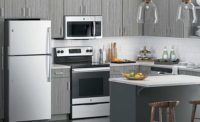Smart Appliances and a Future of Interoperability
Data communications standards can enable appliance manufacturers to achieve robust growth.

The smart appliance industry is currently at a crossroads. Analysts expect to see impressive growth for these products. But several challenges threaten to stymie its progression. On the demand side, consumers were slow to pay higher prices for early-generation smart appliances—likely because it was not clear how the higher costs (i.e. how much more consumers paid) justified the value (i.e. how much more consumers received). Indeed, according to Jabil’s 2018 Connected Home and Building Technology Trends survey, 40% of smart home solutions providers believe that buyers still don’t understand the value of connected appliances.
As my colleague Brent Tompkins wrote in a previous issue, hardware prices have fallen—particularly those concerned with connectivity, which has helped smart appliance manufacturers lower the cost of their products. Yet lower costs alone aren’t enough to ensure the success of today’s smart appliance industry. Convincing consumers of connectivity’s value is a challenge that appliance manufacturers must accept. It’s not just a matter of user education, however. As appliances become more connected, device manufacturers have encountered new technical hurdles to building the case for it. Most notable among these challenges is improving interoperability, which is what translates a collection of smart appliances into a smart home environment.
Just as the human body requires a nervous system, a network of smart appliances needs a centralized but flexible method of communication and control. Today, consumers are using multiple platforms to control disparate devices. This adds complexity and diminishes the smart home’s promise of less hassle and greater precision. If the net value of smart appliances seems insufficient, buyers may dismiss a manufacturer’s core value proposition.
Challenges upon challenges
A recent TED Talk by journalists Kashmir Hill and Suyra Mattu provides some perspective on how net value (i.e. the sum benefits and drawbacks of a more connected home) might play out in the mind of consumers. As an experiment, the team transformed Hill’s apartment into a smart home. The refrigerator, television, and even the toothbrushes were all connected to the internet. To examine and track network activity, Mattu installed a special router. For the next two months, the journalists could tell when the family went to bed and woke up, which TV shows they watched and for how long, and how often they brushed their teeth.
Hill expected her smart home to provide convenience. But that wasn’t her experience. “It wasn’t convenient; it was infuriating,” she explained in the TED Talk. To control all of the smart devices in the home, Hill had to download a dozen apps. She even had to use brand-specific terminology to tell a voice assistant to start the coffee maker. Appliances like a smart vacuum cleaner eliminated a chore but managing all of the connected devices in the home seemed tedious.
Convenience, privacy, and the user interface
Another challenge implicit in the team’s experiment is what value consumers receive in exchange for giving up some privacy. According to Jabil’s survey, 99% of respondents reported that their connected solutions will collect data about consumers who use the product, and a full 100% said that they plan to use this information.
Here too, the onus is on smart appliance manufacturers to educate consumers about what value they are getting for giving up this privacy, and all the perceived risks involved. As the description for Hill’s TED Talk asks, “Once your smart devices can talk to you, who else are they talking to?”
Solving interoperability across smart appliances still leaves these data-privacy concerns. However, interoperability can also be part of the solution if it facilitates a centralized, easy-to-use method for management and control of a smart home’s systems. Buyers want plug-and-play flexibility without the type of hassle that Kashmir Hill experienced.

Planning for interoperability
Data communications standards can help advance this goal and enable appliance manufacturers to achieve expectations of robust growth. In the Jabil survey, 97% of respondents indicated that clear standards for data communications between devices would benefit their business. Nearly 45% of participants reported that data communications standards would allow them to focus on their core strengths instead of focusing on connectivity issues.
Data communications standards would benefit consumers as well. For example, when a user plugs in and turns on a new appliance, the device could connect to the local network and automatically become part of the smart home. This user-friendly approach would eliminate some of the frustrations that consumers have experienced while reinforcing an appliance’s ease-of-use value proposition.
Standards would also support greater interoperability, but appliance manufacturers have taken two different approaches here.
In the Jabil survey, 47% of participants opted for interoperability and are designing their products to work with other connected devices regardless of brand. These appliance manufacturers are more interested in functionality than the user experience. They’re also more likely to provide B2B solutions, such as smart temperature and lighting controls.
The survey further revealed that 45% of solutions providers prefer a controlled approach where their brand delivers all of the needed functionality within a smart home ecosystem. For better or worse, this approach provides the OEM with full control over the customer experience. Given that over 50% of the survey’s respondents reported user interface challenges, a controlled ecosystem may offer some advantages. Yet controls that are too tight can limit inter-device communications, impeding interoperability.
The answer lies somewhere in the middle of these two approaches. Consumers want a plug-and play experience where smart appliances are controlled through voice commands or an intuitive interface. Users also want to protect their digital data. Balancing this concern against ease-of-use isn’t impossible. The rewards are there, and the benefits include more data for OEMs to mine to support product development.
To compete and win the in the marketplace, OEMs need to build trusted relationships with consumers who no longer replace their appliances once every 10 to 15 years. But, to do this they must overcome consumer attitudes toward data privacy and ease-of-use. Improving interoperability with other appliances and smart home features will play a key role in achieving this goal.
Looking for a reprint of this article?
From high-res PDFs to custom plaques, order your copy today!




